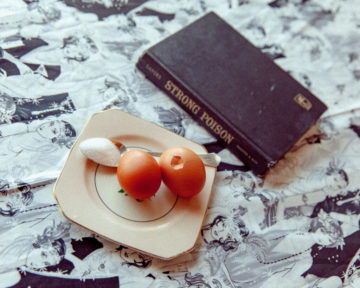Valerie Stivers at The Paris Review:
 Dorothy Sayers’s Strong Poison opens with a description of a man’s last meal before death. The deceased, Philip Boyes, was a writer with “advanced” ideas, dining at the home of his wealthy great-nephew, Norman Urquhart, a lawyer. A judge tells a jury what he ate: the meal starts with a glass of 1847 oloroso “by way of cocktail,” followed by a cup of cold bouillon—“very strong, good soup, set to a clear jelly”—then turbot with sauce, poulet en casserole, and finally a sweet omelet stuffed with jam and prepared tableside. The point of the description is to show that Boyes couldn’t have been poisoned, since every dish was shared, with the exception of a bottle of Burgundy (Corton), which he drank alone. The judge’s oration is another strike against the accused, a bohemian mystery novelist named Harriet Vane, who saw Boyes on the night he died, and had both motive and opportunity to poison him. Looking on from the audience, the famous amateur detective Lord Peter Wimsey writhes in misery; he believes Harriet Vane is innocent, and he has fallen suddenly and completely in love with her.
Dorothy Sayers’s Strong Poison opens with a description of a man’s last meal before death. The deceased, Philip Boyes, was a writer with “advanced” ideas, dining at the home of his wealthy great-nephew, Norman Urquhart, a lawyer. A judge tells a jury what he ate: the meal starts with a glass of 1847 oloroso “by way of cocktail,” followed by a cup of cold bouillon—“very strong, good soup, set to a clear jelly”—then turbot with sauce, poulet en casserole, and finally a sweet omelet stuffed with jam and prepared tableside. The point of the description is to show that Boyes couldn’t have been poisoned, since every dish was shared, with the exception of a bottle of Burgundy (Corton), which he drank alone. The judge’s oration is another strike against the accused, a bohemian mystery novelist named Harriet Vane, who saw Boyes on the night he died, and had both motive and opportunity to poison him. Looking on from the audience, the famous amateur detective Lord Peter Wimsey writhes in misery; he believes Harriet Vane is innocent, and he has fallen suddenly and completely in love with her.
more here.
